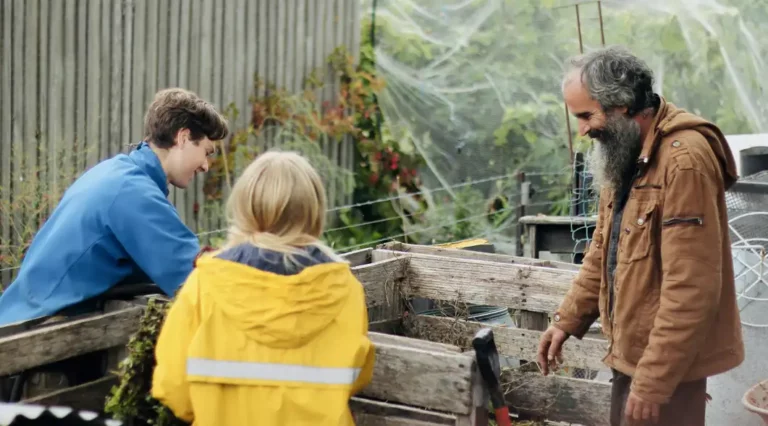The turn off the Albany highway showed us more wheat and grazing paddocks and less canola, reflecting the declining rainfall as you move northeast. But Gnarrojin (Narrogin) is on some of the best soil in the wheatbelt and like York has York Gum (Eucalyptus loxophleba) and Jam (Acacia acuminata) the signature species of the red brown loams. No surprise that the WA College of Agriculture is located there. The town has a population of 4,500 – about the same as Daylesford/Hepburn – but performing the function of a regional centre servicing an extensive hinterland. When the railway closed 15 years ago the population halved to about its current level, and with the deflation of the mining boom housing bubble in 2008 houses fell in price from around half a million to 250,000 and have not changed much in the last decade. Our hosts May and Allan Griffith’s 9 acre property is 15km out of town in the fringes of Cuballing. The grass was wet but not the ground after nothing more than a few showers the previous night. We did a quick set-up of the camper and headed back to town to meet the community gardeners for dinner and to checkout the venue: an ex bowling clubhouse and grounds converted to Gnarrojin Community Gardens in 2013.
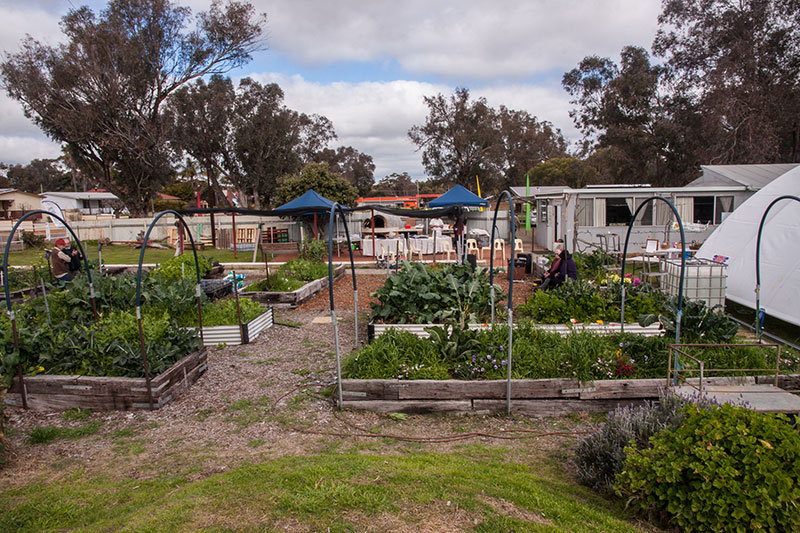
Gnarrojin Community Garden raised beds to give separation from mildly chemical contaminated ground of old bowling green
We got a quick tour and an explanation of the history. Build in the heyday of railway expansion for carting wheat to ports, the bowling club was one of two in the town. Its members were railway workers who mostly lived in modest cottages opposite, while the railway superintendents house overlooking the club was much grander. Once the rail closed, the town downsized in most things including bowling clubs. We heard about managing chemical contamination (a common issue on ex bowling club greens), and met the diverse but mostly older gardeners that formed the core of this very active community group. However David’s attention was diverted by the construction underway in the central open space: a huge shelter of curved gal pipe frames being erected for the event the next day. Would it be ready by 10 am? Would the light levels through the white cover be too bright for the Aussie St presentation? When given a new projector still in its box, to configure and test David’s anxiety rose a notch.
It was the most basic low-res SVGA model you can buy. Tamara, our reliable Permaculture West representative, and her partner Anton arrived and the pot luck dinner was an opportunity to chat with the members. From some of the discussions, it became clear that RetroSuburbia and Aussie St were very relevant to Gnarrojin, but this event was also attracting those in the region interested in what the co- originator of permaculture might have to say about the challenges and opportunities for agriculture. This region has seen the worst impacts of land degradation and climate change, and, conversely, has been the incubator of some the most substantial efforts over many decades to create an agriculture than can endure with our fickle climate and fragile soils.
Next day we awoke to a fog that made us feel at home, had an early morning breakfast with May and Allan, but got to the venue late enough that Tamara was contemplating ringing us to check on our ETA. The massive shelter was up, the pizza oven was going, stalls were being set up. We switched into action mode, with both of us having some nervous moments over tech and logistics before May did an acknowledgement to country and introduction on behalf of the community gardeners while Tamara did the honours representing Permaculture West. David chose to project to the audience of about 50 rather than use a lapel mike with hiss, the blackout on the side wall was just enough to support the small projector image and the Aussie St sound effects defaulted to coming from the laptop half way through. However the audience was one of the most responsive we have had, and even the farmers who came along expecting a serious presentation about permaculture were complementary about the value of Aussie St.
Lunch was local food including flat breads made by Pingelly micro bakery Breadwright from regionally grown and ground biodynamic wheat – not modern wheats that are part of the problem for so many wheat/gluten intolerant people including David. We were very impressed with the whole event in a town that me might have assumed could have been a droll finish to the WA leg of the Retrosuburbia Roadshow. There was no time to take photos because the rest of the afternoon was spent in animated conversations with audience and organisers and singer songwriter Kelly Newton-Wordsworth who, with her husband William are some of the first biodynamic farmers in the west. Other farmers we connected with included David McFall organic farmer from Temple Farm and other farmers working through various brands of regenerative agriculture focused on rebuilding soil carbon in the ways documented by Charles Massy in Call of the Reed Warbler.
We pitched in with the clean up and dismantling of the shelter provided free of charge for the event. Amongst the really interesting bunch of people involved in the community garden, David’s discussions with Don Bird stood out. This quiet, elderly gentleman revealed a depth of knowledge about the land, and is a classic example of the self-taught agricultural engineering innovator – he created the business Bird’s Silos and Shelters, now run by his son Wayne. We headed back to May and Allen’s for a quiet dinner of delicious leftovers and a good night’s sleep.
After a slow start and dither about what to do and where to go we packed up, said our goodbyes to May and Allan who represented for us the best of rural Aussie “battlers” but with a passion for permaculture, family and community health that left us with a deep respect for these folk. It was May who had the vision to convince Tan and Tamara that Gnarrojin Community Gardeners were worthy partners in the Retrosuburbia Roadshow.
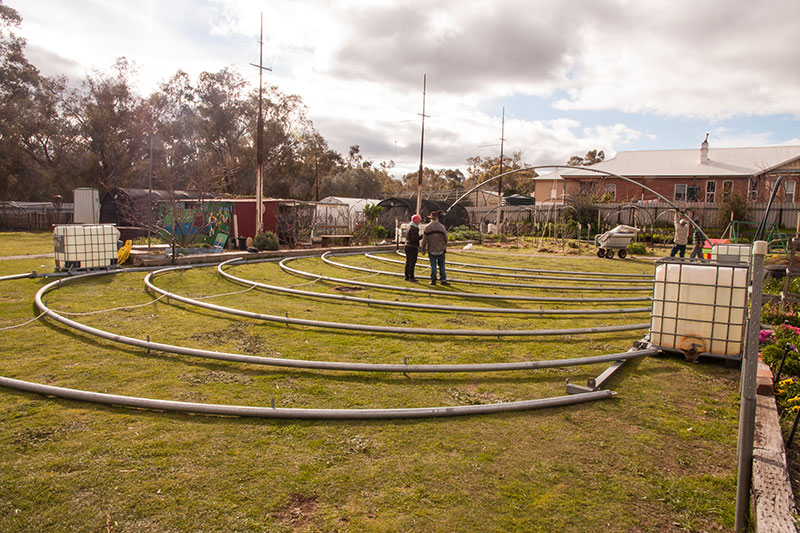
Dismantling the event shelter at the end of the day
In a five minute drive around Cuballing we saw several Bird’s Shelters, before we headed back to town for a visit to Don’s place only a few streets from the community garden. We checked out his aquaponic system growing koi, trout, silver perch, vegies and fruit trees in one of his large shelters that had been in place for over a decade. He was apologetic about the mess but what we saw was quite impressive, even apart from it being the work of a lone man in his 80s. He talked about the building and the systems being made from scrap left over from commercial jobs, the pros and cons of different species of fish, and the role of different plants and parasites in greenhouse pest control. He picked fresh veg for us and proudly gave us a couple of his tree-ripened oranges, which may have been the best we have ever tasted.
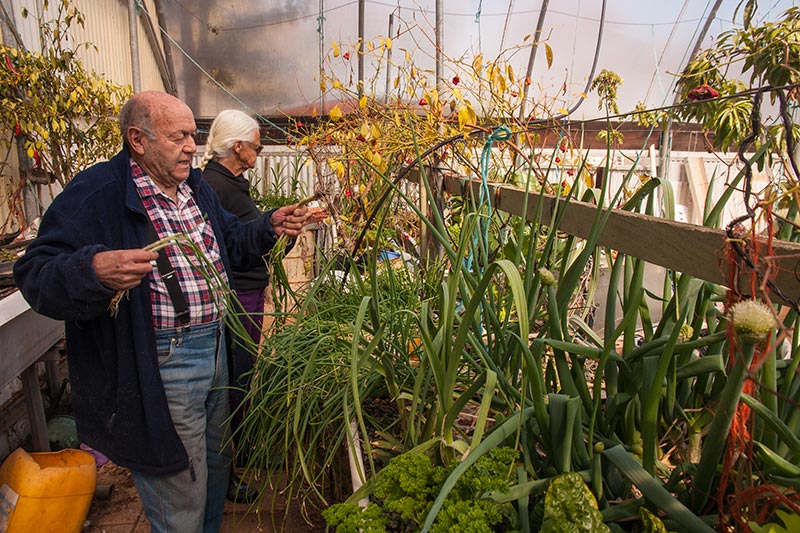
Don Bird and Su picking vegetables inside Don’s backyard aquaponics setup in a ten year old Bird’s shelter
It was very humbling to be with such a gentle and reserved man with a love of nature and the land, who had participated in engineering innovation for both broad acre agriculture and mining, and then applied that same innovation in his hobby, producing exotic backyard food that was health giving and enticing. The other gift from Don was the suggestion that the canopy makers at Bird’s Silos and Shelters could make us a new cover for True Blue from their high-tech Australian made shelter fabric. Su had been trying to organise a new cover last minute before we left home and everywhere we stayed for long enough.
We stopped for lunch at the railway dam reserve, which had once been the supply of water for steam trains until salinity, then a fresher supply from the Collie pipeline in 1956, and finally, replacement of steam locos with diesel electrics ones in 1971, saw it abandoned. On the chance we could have a cover made, we decided to camp near town and ring them first thing Monday morning. The Railway dam was too close to town, so we checked out the Foxes Lair Nature Park but signs indicated no fires so we headed south towards some nice patches of unfenced bush that make up the Highbury State Forest. Our camp in the wandoo woodland had a long view to the south over sheep grazing paddocks with piles of granite rocks, a product of the shift to higher levels of cropping in the wheatbelt and less grazing.
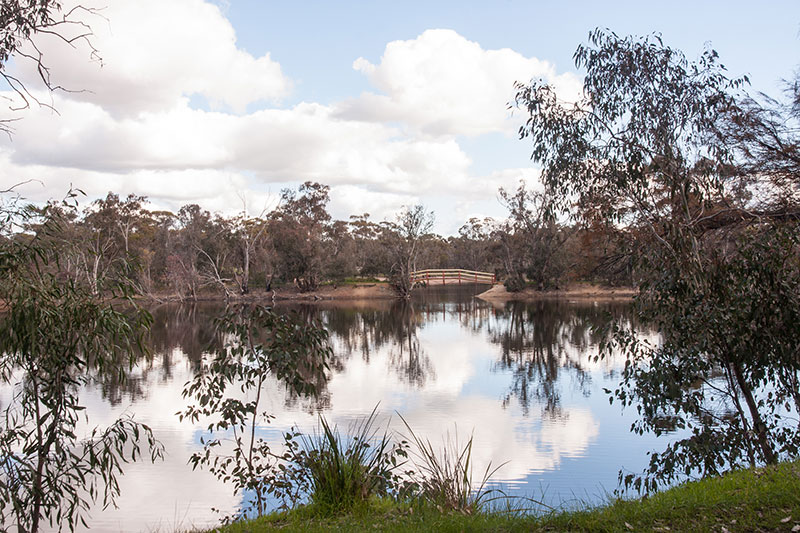
The Gnarrojin railway dam
Bird’s Silos and Shelters is a substantial rural engineering enterprise at Popanyinning a railway siding settlement 45 km north of Gnarrojin where they could represent 95% of local employment. The canopy maker we saw cutting up fabric for one of their massive shelters said he could do the job on the spot and gave us a price estimate.
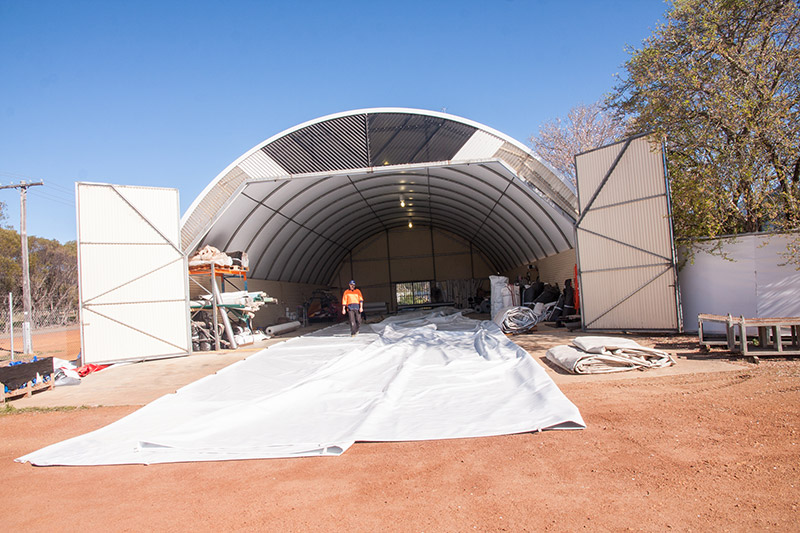
Making canopies for shelters at Popanyinning
Su checked in the office with the boss Wayne, a laid back guy who seemed like a “chip off the block” of his father Don. The price was way less than quotes we had across the country, so we decamped to the local café for cap and hot choc, and power for the laptop and business. While Cullen Winery in Margaret River was definitely the most upmarket drinks venue we had entered on the trip, Popanyinning won the prize for the most downmarket and Su wasn’t even upset when our drinks came in throw away cups after Don had showed us how upside down they make the perfect pots for raising seedlings with no root disturbance.
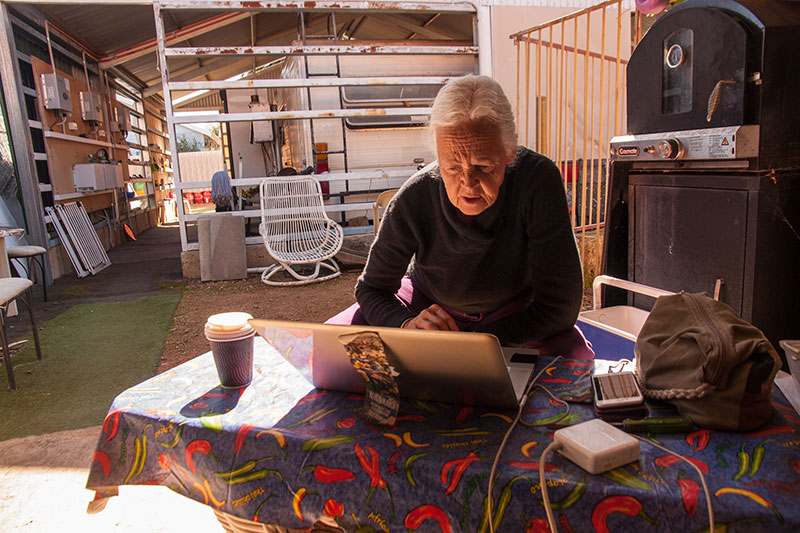
Su doing deskwork at the Popanyinning café
By midday we were back in Gnarrojin to check out Wild and Waste Free, an example of the alternative food businesses getting a start in a town with a lot of vacant shops putting downward pressure on rents. Unfortunately it is closed Mondays but we did a walk around, checked estate agent windows showing prices ranging from under 100k for “shacks” to a top of 500k for “palaces”. On a suggestion from David, Su decided to try Denman Tech to replace a failing IPhone battery. A couple of hours later we had a new battery, button and screen for a price that seemed fair and left hoping our lifeline to family, friends and finance would be more resilient after the transplant surgery.
For David with future visions of a climate-impacted wheatbelt, coming to Gnarrojin, the event at the Gnarrojin Community Garden and meeting Don Bird, amongst others, felt like elements for a gritty but hopeful future – not unlike “History from the Future” written about our own region of central Victoria. Gnarrojin’s underused building stock, north-south grid (for replicable solar access and retrofit), microclimates from hillside to creek flats, local water catchment and supply (currently backed by piped water from Collie), a still- functioning rail line and predominantly good soils suggested a lot of elements for a retrosuburban future. Strong connections to the minority of farmers providing diverse models of regenerative agriculture no so beholden the Monsanto and the big banks could provide the basis of the parallel bioregional food system outlined in “Feeding Retrosuburbia: from the backyard to the bioregion”.
It would be wrong to overplay the potential we saw at Gnarrojin, because everywhere in this still lucky country has huge potential to chart diverse prosperous ways down from the energy mountain articulated in the introduction to Permaculture: Principles and Pathways Beyond Sustainability. We expected to see those elements of a positive future in progressive and cool places like Fremantle and Margaret River but maybe had less expectation of seeing those elements in places with tougher climates and economies such as Gnarrojin.
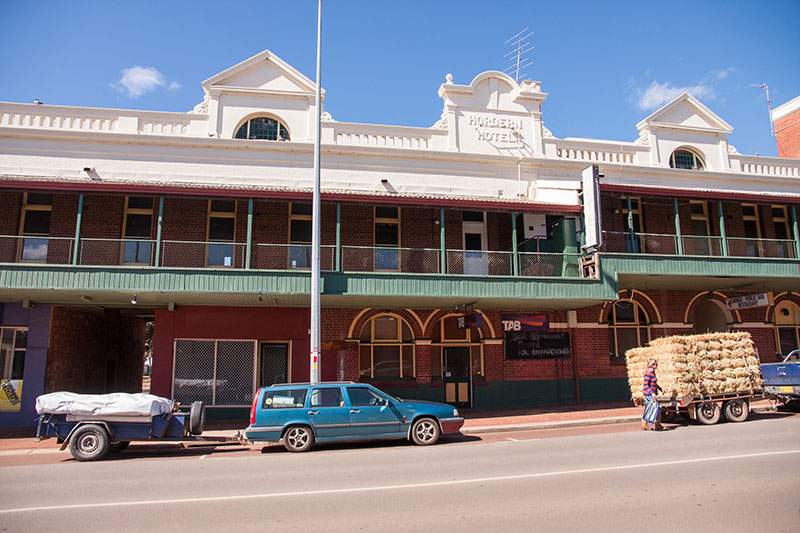
One of the many underused building in Gnarrojin, and perhaps a place David’s father Jack stayed when working as a travelling book salesman in the 1950s
<< Previous Chapter — — — Next Chapter >>





































